Abstract
There are doubts regarding the empirical benefits of forecast aggregation. Theoretical research clearly supports forecast aggregation but conflicting results exist in the empirical literature. We search the literature for empirical regularities. One important issue often cited is estimation error and papers which are unsupportive of forecast aggregation often have short spans of data. A second empirical regularity is that researchers frequently use a relatively small number of disaggregates. Our work finds that the greatest benefits to aggregation are realised when a large number of disaggregates are used. This is a natural consequence of the theoretical results. A second critical issue in forecast aggregation is model selection. We suggest a simple guide to model choice based on the empirical properties of the data. In this regard, the extent of comovements between the constituent series determines model choice.








Similar content being viewed by others
Notes
A positive oil price shock would cause most of the inflation series to increase.
Available at: http://www.bea.gov/national/nipaweb/SelectTable.asp.
It is \(\frac{400}{h}\) in the case of quarterly data and \(\frac{1200}{h}\) in the case of monthly data.
\(N_{s}\) is the number of series in the \(sth\) set of disaggregate series; \(s=\left\{ 1,2,3,4\right\} \) in the case of US dataset and \(s=\left\{ 1,2,3\right\} \) in the case of Euro area dataset.
A scale parameter, to fix the variance of the coefficients, is set by estimating the variance of the residuals from a univariate model of order \(p\) on the single variables \(p_{j,t}\).
As robustness check, in the last section of the paper, we report a set of results for an alternative price transformation (for the US dataset).
References
Atkeson A, Ohanian L (2001) Are Phillips Curve useful for forecasting inflation Reserve Bank of Minneapolis. Q Rev 25(1):2–11
Banbura M, Giannone D, Reichlin L (2010) Large Bayesian VARs. J Appl Econom 25(1):71–92
Benalal N, Diaz del Hoyo JL, Landau B, Roma M, Skudelny F (2004) To aggregate or not to aggregate? Euro area inflation forecasting. ECB Working Paper 374
Bruneau C, De Bandt O, Flageollet A, Michaux E (2007) Forecasting inflation using economic indicators: the case of France. J Forecasting 26:1–22
Clark T, West K (2007) Approximately normal tests for equal predictive accuracy in nested models. J Econom 138:291–311
D’Agostino A, Gambetti L, Giannone D (2013) Macroeconomic forecasting and structural change. J Appl Econom 28(1):82–101
D’Agostino A, Surico P (2012) A century of inflation forecast. Rev Econ Stat MIT press 94(4):1097–1106
Domlas J (2005) Commentary, Federal Reserve Bank of Dallas Working Paper 0506
Duarte C, Rua A (2007) Forecasting inflation through a bottom-up approach: how bottom is bottom? Econ Model 24(6):941–953
Enders W (2010) Applied econometric time series, 3rd edn. Wiley, New York
Hendry DF, Hubrich K (2006) Forecasting aggregates by disaggregates. European Central Bank Working Paper 589
Hendry DF, Hubrich K (2011) Combining disaggregate forecasts or combining disaggregate information to forecast an aggregate. J Bus Econ Stat 29(2):216–227
Hubrich K (2005) Forecasting euro area inflation: does aggregating forecasts by HICP component improve forecast accuracy? Int J Forecasting 21:119–136
Kohn R (1982) When is an aggregate of a time series efficiently forecast by its past? J Econom 18:337–349
Litterman RB (1986) Forecasting with bayesian vector autoregressions—five years of experience. J Bus Econ Stat 4(1):25–38
Luetkepohl H (1984a) Forecasting contemporaneously aggregated vector ARMA processes. J Bus Econ Stat 2(3):201–214
Luetkepohl H (1984b) Linear transformations of vector ARMA processes. J Econom 26:283–293
Luetkepohl H (2010) Forecasting non-linear aggregates and aggregates with time-varying weights EUI Working Paper, No. 2010/11
Marcellino M, Stock JH, Watson MW (2003) Macroeconomic forecasting in the Euro area: country specific versus area-wide information. Eur Econ Rev 47(1):1–18
Moser G, Rumler F, Scharler J (2007) Forecasting Austrian inflation. Econ Model 24(3):470–480
Rose DE (1977) Forecasting aggregates of independent ARIMA processes. J Econom 5:323–345
Stock JH, Watson MW (2002) Macroeconomic forecasting using diffusion indexes. J Bus Econ Stat 20(2):147–162
Stock JH, Watson MW (2007) Why has US inflation become harder to forecast? Journal of Money Credit Bank 39(1):3–33
Tiao GC, Guttman I (1980) Forecasting contemporal aggregates of multiple time series. J Econom 12: 219–230
Zellner A, Tobias J (2000) A note on aggregation, disaggregation and forecasting performance. J Forecasting 19:457–469
Author information
Authors and Affiliations
Corresponding author
Additional information
The views expressed in this paper are those of the authors, and do not necessarily reflect those of the Central Bank and Financial Services Authority of Ireland or the European Stability Mechanism. The paper was written and submitted when Antonello D’Agostino was working at the Central Bank of Ireland.
Rights and permissions
About this article
Cite this article
Bermingham, C., D’Agostino, A. Understanding and forecasting aggregate and disaggregate price dynamics. Empir Econ 46, 765–788 (2014). https://doi.org/10.1007/s00181-013-0685-6
Received:
Accepted:
Published:
Issue Date:
DOI: https://doi.org/10.1007/s00181-013-0685-6




